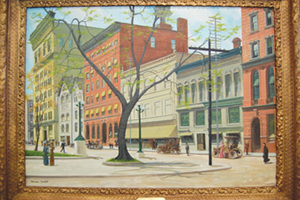HAMILTON, Ont. - A screaming child greets every visitor to the offices of Scarfone Hawkins LLP.

Luckily for those with sensitive hearing, it’s a silent scream. Michael Briand’s haunting “Portrait of a Steel Town Child,” which features a faded sketch of a child in apparent agony peering out of a metal plate, sits in a corner of the Hamilton firm’s 14th-floor lobby.
The spookiness of the “hunk of rotting steel,” as described by David Thompson, the partner who chose the work, is enhanced by the dim lighting in the reception.
“Everyone thought I was wacky, but I like stuff that is a little bit out there,” Thompson says. “I remember people saying, ‘You’ve got to be kidding. We’re not buying that.’ But I think it’s great.”
The class action litigator offered to put the work in his own office if nobody else would agree on the selection, but the moving piece has become a mainstay and talking point in its prominent spot.
Thompson’s own work frequently takes him to downtown Toronto, where he marvels at the collections of larger firms. “I love going down to their offices because I’m blown away by some of the art that’s in their collections,” he says.
“It always astounds me, and you can only imagine how enormously expensive they must be. We’ve tried in our own humble way to put together a little collection.”
There’s a local connection to many of the works in the Scarfone Hawkins collection as many Hamilton-area landmarks featuring heavily. In “Early Dundurn,” for example, Maria Panko captures the 19th-century castle soon after its completion in 1835.
The steel plants with which the city remains synonymous appear in a number of works and are evoked in several others, including Frances Ward’s “Turnings.” Little springs and metal pieces jut out from the canvas to give the painting a third dimension.
“We try to be good local supporters, in particular for Hamilton itself, because Hamilton needs all the help it can get,” Thompson says. “We’re a Hamilton-based firm, our clients are Hamilton-based, so our support would be for local artists.”
Near a window that looks out onto James Street in downtown Hamilton, a painting by Paul Duff shows the same streetscape more than 100 years ago that looks remarkably similar to the present despite the changes in transport and fashion.
“I love the dresses they’re wearing in that one,” says Cindy Yates, a law clerk at the firm.
Upstairs, opposite some old shelves packed with aging legal reference books, there’s another piece that’s also local that she’s not so enthusiastic about.
The colourful version of the famous Hamilton farmers’ market, full of shoppers with exaggerated features, isn’t to her taste. “This is the ugliest piece we have, and I think that’s why it’s here where nobody has to see it,” she says jokingly.
“Nobody uses this library anymore because everything’s online now.”
The firm began its collection about seven years ago after moving into its new office.
“We renovated this space and, of course, we had blank walls,” says Thompson. “Apart from each lawyer with their own little piece of art in their offices, we didn’t have anything as a firm.”
The firm then called on the local Dundas Valley School of Art to commission a number of pieces so it could choose some of its favourites. Partner Jeffrey Teal sat on the board of the school, while the wife of James Scarfone, another partner, had taken classes there.
“It seemed to be a natural fit,” Thompson says. “It was lucky that we all seemed to share an appreciation of art and a desire to support the local arts community. And the school was absolutely thrilled.”
After an open call to students and alumni of the school, the firm’s eight partners made the trip to pick up about 20 pieces for a total of approximately $25,000.
“As a small law firm, that was quite a significant investment,” Thompson says.
Most of the choices were through consensus among the partners, but the lawyers also had their personal wild-card choice. That’s when Thompson made his pitch for the piece by Briand, who at the time was a first-year student at the school.
Over the next few years, the firm supplemented the original collection with additional works purchased at the art school’s annual auction until the walls were complete.
“We should probably buy some more pieces,” says Thompson, nodding to a large blank space on the wall of his own office. “We got all excited and bought a lot, but there’s still some spots that need to be filled. We’ve become a bit complacent. Maybe this attention will spur us on.”

 Luckily for those with sensitive hearing, it’s a silent scream. Michael Briand’s haunting “Portrait of a Steel Town Child,” which features a faded sketch of a child in apparent agony peering out of a metal plate, sits in a corner of the Hamilton firm’s 14th-floor lobby.
Luckily for those with sensitive hearing, it’s a silent scream. Michael Briand’s haunting “Portrait of a Steel Town Child,” which features a faded sketch of a child in apparent agony peering out of a metal plate, sits in a corner of the Hamilton firm’s 14th-floor lobby.